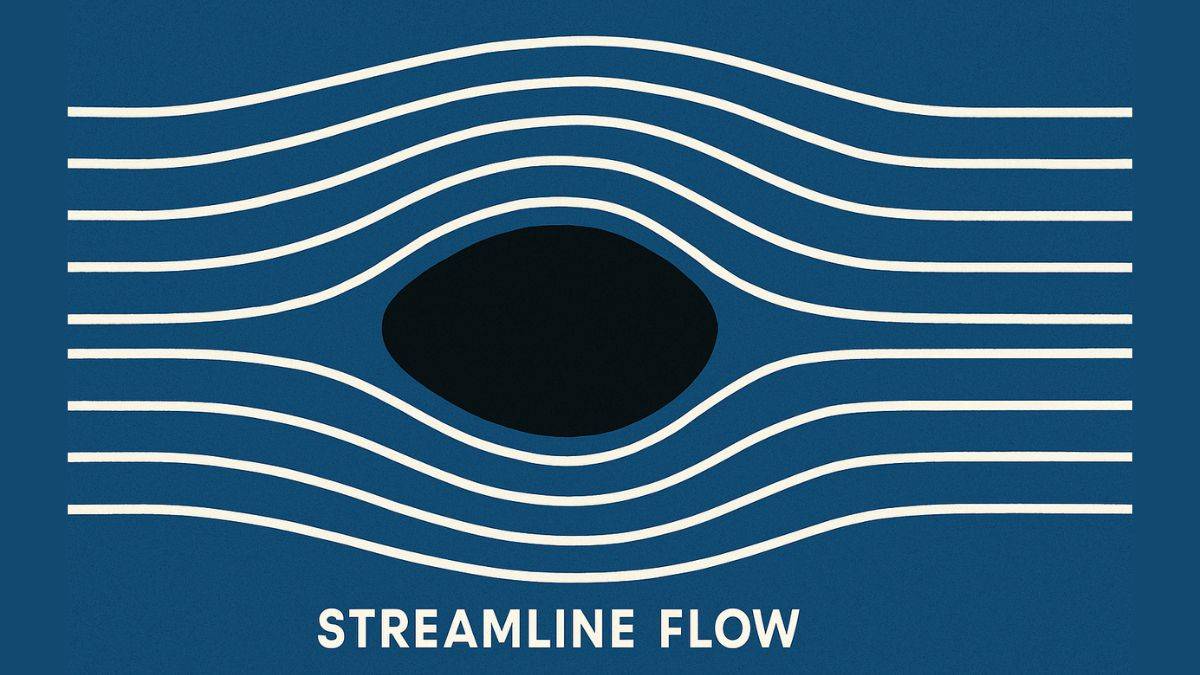
Streamline flow is a well-defined path or line followed by fluid for smooth and orderly movement. In this type of flow, the particles move in parallel paths and they never cross each other. Also, the velocity of fluid at a given point remains constant with time.
When a fluid moves slowly through a narrow pipe, it forms streamline flow. It is also known as laminar flow.
Streamline flow is an important topic in the mechanical properties of fluids. Understanding the topic will help us know how fluids behave in pipes, blood flow in our body, and the aerodynamics of vehicles.
Important Links:
| NCERT Class 11 Notes | |
| Class 11 Chemistry NCERT Notes |
- Definition of Streamline Flow
- Key Characteristics of Streamline Flow
- Mathematical Insight: Continuity Equation in Streamline Flow
- Applications of Streamline Flow
- Sample JEE Main-Level Problems
- Study Materials for CBSE Class 11
- Class 11 Physics NCERT Notes
Definition of Streamline Flow
Streamline flow is a type of fluid motion in which the particles of fluid flow in parallel layers without disruption. In this type of motion, the fluid particles follow a steady path called a streamline. These paths never cross each other. Streamline flow is also known as laminar flow.
Key Characteristics of Streamline Flow
The key characteristics of streamline flow are:
Orderly Motion
The flow of Fluids is a smooth and well-defined path called streamlines. Their path do not cross each other.
Constant velocity at a point
The velocity of fluid at a given point remains constant with time.
No mixing of layers
Adjacent fluid layers flow over each other without crossing. This makes the flow smooth and predictable.
Low-speed condition
When fluid flows slowly through a narrow tube, streamline (laminar flow) occurs.
Reynolds Number
The flow of fluid particles is streamlined if the Reynolds number is less than 2000.
Also Check:
| NCERT Class 12 notes | |
| Maths Class 12 NCERT Notes |
Mathematical Insight: Continuity Equation in Streamline Flow
The equation of Continuity is a basic principle in fluid dynamics that explains the conservation of mass in a flowing fluid. As per the equation, the mass of fluid entering through one end of the tube per unit time is equal to the mass of fluid leaving the tube per unit time.
Read More: NCERT Solutions for Class 11 & 12
Mathematical Form (for incompressible fluid):
where,
- and are sectional areas of different points in the pipe.
- and are fluid velocities.
Explanation
- Velocity increases the fluid flowing through a narrow pipe section.
- Widen the pipe, velocity decreases.
- The area and velocity product remains constant to conserve mass flow rate.
Applications of Streamline Flow
Streamline flow is used in science, engineering, and medical fields. The important applications of streamline flow are:
- Blood flow in arteries and veins:
- The blood flow in the human body is streamlined manner. The blood flow through smaller blood vessels ensures efficient and silent circulation.
- Oil and Gas Pipeline
- To reduce the energy loss due to friction and to maintain steady transport of fluids, streamline flow is preferred.
- Water flow in Irrigation Channels
- Streamlined water flow in agriculture ensures even distribution with no erosion or turbulence.
- Inkjet Printers
- The movement of ink droplets for precise printing is controlled through streamlined flow.
Sample JEE Main-Level Problems
- Water flows through a pipe of diameter 4 cm at a speed of . If the pipe narrows to 2 cm, calculate the new velocity, assuming streamline flow. Use the continuity equation.
- For water ( ) flowing at in a 3 cm diameter pipe, calculate the Reynolds number and determine if the flow is streamline or turbulent. [Hint: Use .
Study Materials for CBSE Class 11
Students can find here the CBSE NCERT Class 11 notes.
Class 11 Physics NCERT Notes
Students can find here the NCERT notes link for the complete chapter of Class 11 Physics.
| Units and Measurements Class 11 Notes | Mechanical Properties of Solids Class 11 Notes |
| Motion in a Straight Line Class 11 Notes | Mechanical Properties of Fluids Class 11 Notes |
| NCERT Class 11 Notes for Motion in a Plane | Thermal Properties of Matter Class 11 Notes |
| Laws of Motion Class 11 Notes | Thermodynamics Class 11 Notes |
| Work, Energy, and Power Class 11 Notes | Kinetic Theory of Gas Class 11 Notes |
| System of Particles and Rotational Motion Class 11 Notes | Oscillations Class 11 Notes |
| Gravitation Class 11 Notes | Waves Class 11 Notes |
Physics Mechanical Properties of Fluids Exam
Student Forum
Other Topics under this Chapter
Other Class 11th Physics Chapters
- Physics Mechanical Properties of Solids
- NCERT Class 11 Physics
- NCERT Class 11 Notes
- NCERT Notes
- Physics Motion in Plane
- Physics Mechanical Properties of Fluids
- Physics Motion in Straight Line
- Physics System of Particles and Rotational Motion
- Physics Oscillations
- Physics Waves
- Physics Thermal Properties of Matter
- Physics Motion
- Physics Gravitation
- Physics Thermodynamics
- Physics Work, Energy and Power
- Physics Units and Measurement
- Physics Laws of Motion

